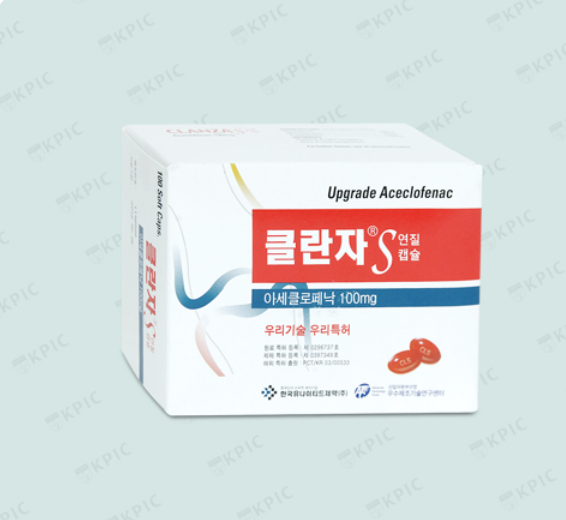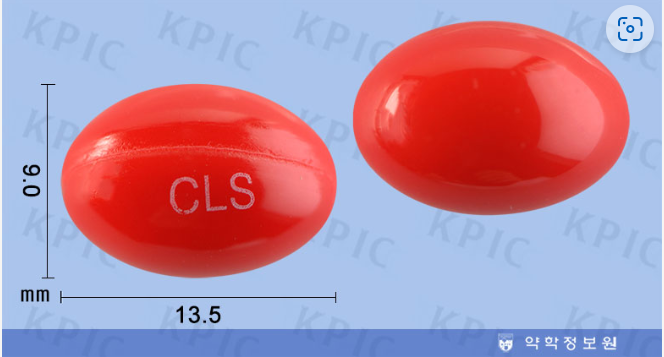Klanzas Soft Capsule is a nonsteroidal anti-inflammatory analgesic and has the effect of relieving inflammation and pain. By learning more about this medicine, let's understand the right ways and precautions to take and aim for a healthy life. This article describes the efficacy, usage, and precautions of the Klanzas soft capsule.

Effect of Klanzas Soft Capsule
Rheumatoid arthritis, ankylosing spondylitis, osteoarthritis (degenerative arthritis) and arthroplasia of the scapula, toothache, post-traumatic inflammation, back pain, sciatic pain, and non-segmental rheumatism

Clanzas Soft Capsule Usage Capacity
Adults take 100 mg once as accelophenac twice a day every 12 hours.
In patients with liver failure, 100 mg per day is administered at the initial dose.
Do not chew or break this medicine, but take it as it is.
Increase or decrease according to symptoms.
The drug should be administered for the shortest time with the lowest effective dose to minimize cardiovascular adverse reactions.
medication information
- Gastrointestinal disorders can occur. If the symptoms are severe, consult an expert.
- Those who drink regularly should consult an expert before administering this medicine.
- Pregnant women and women planning to conceive should consult an expert before administration.
- Do not use it with other anti-inflammatory analgesics without consulting an expert.
Precautions for Use of Clanzas Soft Capsules
1. If you regularly drink more than three cups of alcohol every day, you should consult your doctor or pharmacist.
2. Cardiovascular risk can increase the risk of microcerebral blood relationships.
3. This may increase the risk of significant gastrointestinal adverse reactions, including bleeding, ulcers, and perforation of the stomach or intestines. Clanzas Soft
Capsule Storage and Handling Precautions
1. Store out of reach of children.
2. Replacement in another container may cause an accident or is not desirable in terms of quality maintenance, so be careful.
2. Do not administer to the next patient (in the case).
1) Patients with active peptic ulcers/bleeding or a history of it
2) Patients who are overreacting to this drug and its components or to some drugs of the same family (diclofenac)
3) Patients with a history of asthma, urticaria, or allergic reactions to aspirin or other nonsteroidal anti-inflammatory drugs (including COX-2 inhibitors) (a fatal severe anaphylaxis-like response has rarely been reported after administration of nonsteroidal anti-inflammatory drugs in these patients)
4) Asthma patients with increased risk of asthma, urticaria, or acute rhinitis caused by aspirin or other drugs with prostaglandin synthase inhibition
5) Treatment of pain before and after coronary bypass surgery (CABG)
6) Patients with severe heart failure and congestive heart failure (NYHA II to IV), patients with ischemic heart disease, peripheral arterial disease and/or cerebrovascular disease
7) a patient with severe renal impairment
8) a patient with severe liver failure
9) Patients with a history of gastrointestinal bleeding or perforation due to past treatment with nonsteroidal anti-inflammatory analgesics
10) a pregnant woman at the end of her pregnancy
11) A nursing woman
12) Patients with inflammatory bowel disease such as Crohn's disease or ulcerative colitis
13) Patients with bleeding or blood coagulation disorder
14) Patients who are sensitive to soybean oil or have a history of allergies
15) Patients who are sensitive to beans or peanuts 3. The next patient should be carefully administered.
1) a patient with a renal disorder or a history of it
2) a patient with fluid retention or heart failure
3) Patients receiving diuretics or ACE inhibitors
4) a patient in remission after surgical treatment 5) an elderly person
6) Patients with bronchial asthma or a history thereof (bronchial spasm has been reported with administration of nonsteroidal anti-inflammatory analgesics)
7) a congenital patient with porphyrin metabolism
8) a patient with high blood pressure
9) a patient with liver failure or a history of it
10) Patients with gastrointestinal ulcers due to long-term administration of nonsteroidal anti-inflammatory analgesics in the past, who are receiving both long-term administration of this drug such as micro-prostol (there is also a digestive ulcer that is resistant to treatment by micro-prostol.)
11) A woman who is pregnant in the early or mid-term pregnancy or who is likely to be pregnant, and a woman planning to become pregnant
12) Patients receiving anticoagulants
13) Patients with abnormal fat metabolism, such as hyperproteinemia, diabetic hyperlipidemia, and pancreatitis, or patients who need to carefully administer lipid emulsions 14) This drug contains yellow No. 4 (tartrazine), so it is sensitive to this ingredient or has a history of allergies Care should be taken to patients with . 4. Abnormal reaction Most commonly, gastrointestinal adverse reactions, dizziness, and liver enzyme levels have been reported. Rare skin abnormalities, including itching and rashes
1) Blood and lymphatic systems: rare anemia, very rare leukopenia, thrombocytopenia, neutrophil reduction, hemolytic anemia, regenerative anemia, and agranulocytosis
2) Hypersensitivity: Rare shock, anaphylaxis reaction
3) Metabolism: Very rarely hyperkalemia
4) Mental nervous system: frequent dizziness Very rarely depression, strange dreams, sleeplessness
5) Sensory machinery: rare visual impairment, optic nerve inflammation Very rarely sensory abnormalities, progression, drowsiness, headache, palate disorders, woody, fever or directional sensory disorders, delirium, hallucinations, tinnitus, boredom
6) Circulatory machinery: Very rarely, heart attack, facial flushing can occur. High blood pressure and heart failure have been reported in relation to nonsteroidal anti-inflammatory analgesics. Acerclophenac is structurally similar to diclophenac and is metabolized to diclophenac, so many clinical and epidemiological data have shown an increased risk of arterial thrombosis (myocardial infarction or stroke, especially in long-term treatment at high doses). Epidemiological data also showed an increased risk of acute coronary syndrome and myocardial infarction in relation to accelophenac administration.
7) Respiratory system: rare shortness of breath Very rare bronchial spasms, stenosis
8) Digestive machinery: Most often gastrointestinal abnormalities are observed. Digestive ulcers, perforation or gastrointestinal bleeding appear, sometimes severe, and more severe in the elderly. Frequent indigestion, abdominal pain, nausea, diarrhea Sometimes abdominal bloating, gastritis, constipation, vomiting, rare black stools in mouth ulcers, very rarely stomatitis, vomiting, pancreatitis, exacerbation of colitis, Crohn's disease
9) Liver: Very rarely elevated hepatitis, jaundice, AST, ALT, and ALP
10) Skin: Sometimes itching, rash, redness, dermatitis, urticaria rarely, facial edema very rarely, violet, blistering dermatitis, skin mucosal syndrome (Stevens-Johnson syndrome), and toxic epidermal necrosis (Liel syndrome). photoreceptive to hair loss
11) Kidney: Kidney failure, kidney syndrome
12) Local reaction: edema, fatigue, leg cramps 13) Other: autoimmune diseases such as frequent liver enzyme rise, sometimes blood urea or creatinine rise, weight gain, night urination increase, aseptic meningitis (especially systemic lupus (SLE) and mixed connective tissue disease (MCTD)
14) Add the following adverse reactions according to the analysis and evaluation of domestic side effect report data. - Skin: vascular edema - Other: peripheral edema, edema around eyes General precautions
1) Before administering this drug, the potential risks and benefits of this drug and other alternative treatments should be considered. The drug is administered at the minimum effective dose for the shortest possible time to match the treatment purpose of each patient.
2) Gastrointestinal Abnormal Response: Extreme care should be taken when prescribing nonsteroidal anti-inflammatory analgesics, including this drug, to patients with a history of ulcerative disease or gastrointestinal bleeding. Patients with a history of peptic ulcer disease and/or gastrointestinal bleeding increased the risk of gastrointestinal bleeding by more than 10 times when administered with nonsteroidal anti-inflammatory analgesics compared to patients without these risk factors. Other risk factors that increase gastrointestinal bleeding include oral corticosteroids or anticoagulants, long-term alcohol consumption of nonsteroidal anti-inflammatory analgesics, old age, and weak health conditions. Since most of the voluntary reports of fatal gastrointestinal adverse reactions are for the elderly and the weak, special care should be taken when administering this drug to these patients.
3) High blood pressure: Nonsteroidal anti-inflammatory drugs, including this drug, can cause high blood pressure or worsen existing high blood pressure, which can increase the incidence of adverse cardiovascular cases. When patients taking thiazide or loop diuretics take nonsteroidal anti-inflammatory analgesics, their response to these treatments may be reduced. Nonsteroidal anti-inflammatory drugs, including this drug, should be administered carefully in patients with hypertension. Blood pressure should be closely monitored at the beginning and during the administration period of this drug.
4) Congestion heart failure and edema: Body fluid retention and edema were observed in some patients taking nonsteroidal anti-inflammatory analgesics, including this drug. This drug should be administered carefully in patients with fluid retention or heart failure.
5) Long-term use of nonsteroidal anti-inflammatory analgesics can cause kidney papillary necrosis or other kidney damage. In addition, since the role of prostaglandin is important in maintaining renal blood flow, special attention is needed in patients with heart failure, renal failure, liver failure, patients receiving diuretics or ACE inhibitors, and the elderly. If medication is stopped, most of them will recover to their pre-treatment status.
6) Advanced renal disease: No controlled clinical trials have been conducted on the use of this drug in patients with advanced renal disease. Therefore, administration of this drug is not recommended for patients with advanced renal diseases. If administration of this drug should be initiated, the patient's kidney function should be closely monitored.
7) The administration of nonsteroidal anti-inflammatory drugs, including this drug, may cause an increase in liver function levels. These abnormal test levels may worsen, remain unchanged, or may be temporary as treatment continues. In addition, severe liver-related adverse reactions, including jaundice, fatal fulminant hepatitis, liver necrosis, and liver failure (some are fatal), have been rarely reported due to the administration of nonsteroidal anti-inflammatory analgesics including this drug. Patients with symptoms and/or signs suggesting liver function abnormalities or abnormal liver function tests should carefully observe for deterioration of liver function during the administration period, and if clinical symptoms or systemic signs related to liver disease (e.g., eosinophilia, rash) should be stopped.
8) Since anemia may occur due to the administration of nonsteroidal anti-inflammatory drugs including this drug, hemoglobin or hematocrit tests should be performed if symptoms or signs of anemia appear due to long-term administration of this drug. Nonsteroidal anti-inflammatory analgesics have been found to inhibit platelet aggregation and to extend bleeding time in some patients. Unlike aspirin, the drug's effect on platelet function is relatively small, short-lived, and reversible. Patients who have coagulation-related diseases or who may be negatively affected by platelet function changes, such as those who are administering anticoagulants, do not administer this drug.
9) For use in chronic diseases, consider the following.
(1) Patients with long-term administration of nonsteroidal anti-inflammatory analgesics should undergo regular whole-cell tests (CBC) and biochemical tests. If clinical symptoms or systemic signs associated with liver disease or renal disease (e.g., eosinophilia, rash) or abnormal liver or renal test results persist or worsen, the administration of this drug should be stopped.
(2) Treatments other than medication are also considered.
10) When used for acute diseases, consider the following.
(1) It is administered in consideration of the degree of acute inflammation, pain, and fever.
(2) In principle, long-term administration of the same drug is avoided.
(3) If there is a cause therapy, do it.
11) Anaphylaxis-like response: Like other nonsteroidal anti-inflammatory analgesics, anaphylaxis-like reaction can occur in patients who have no experience in drug exposure.
댓글